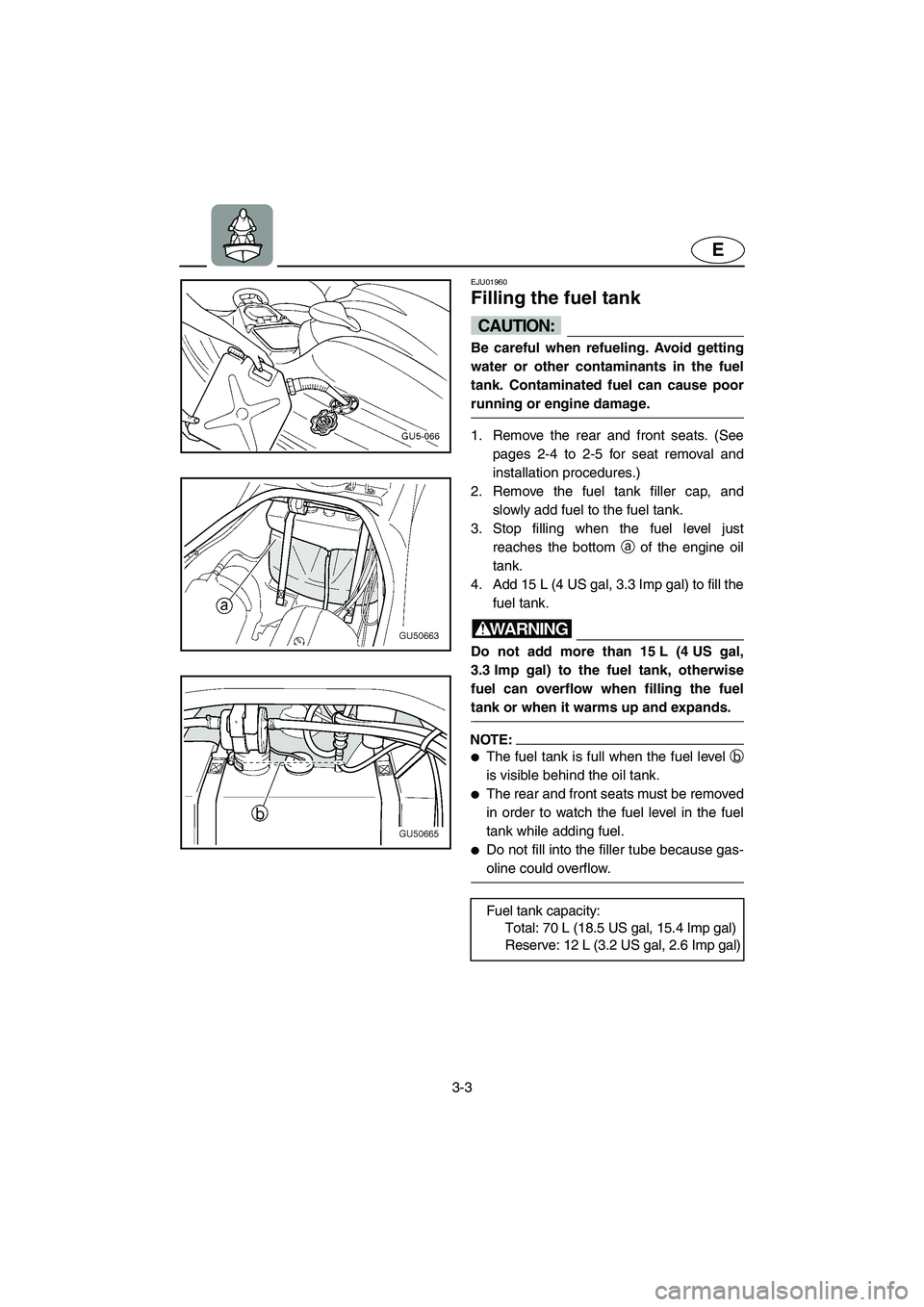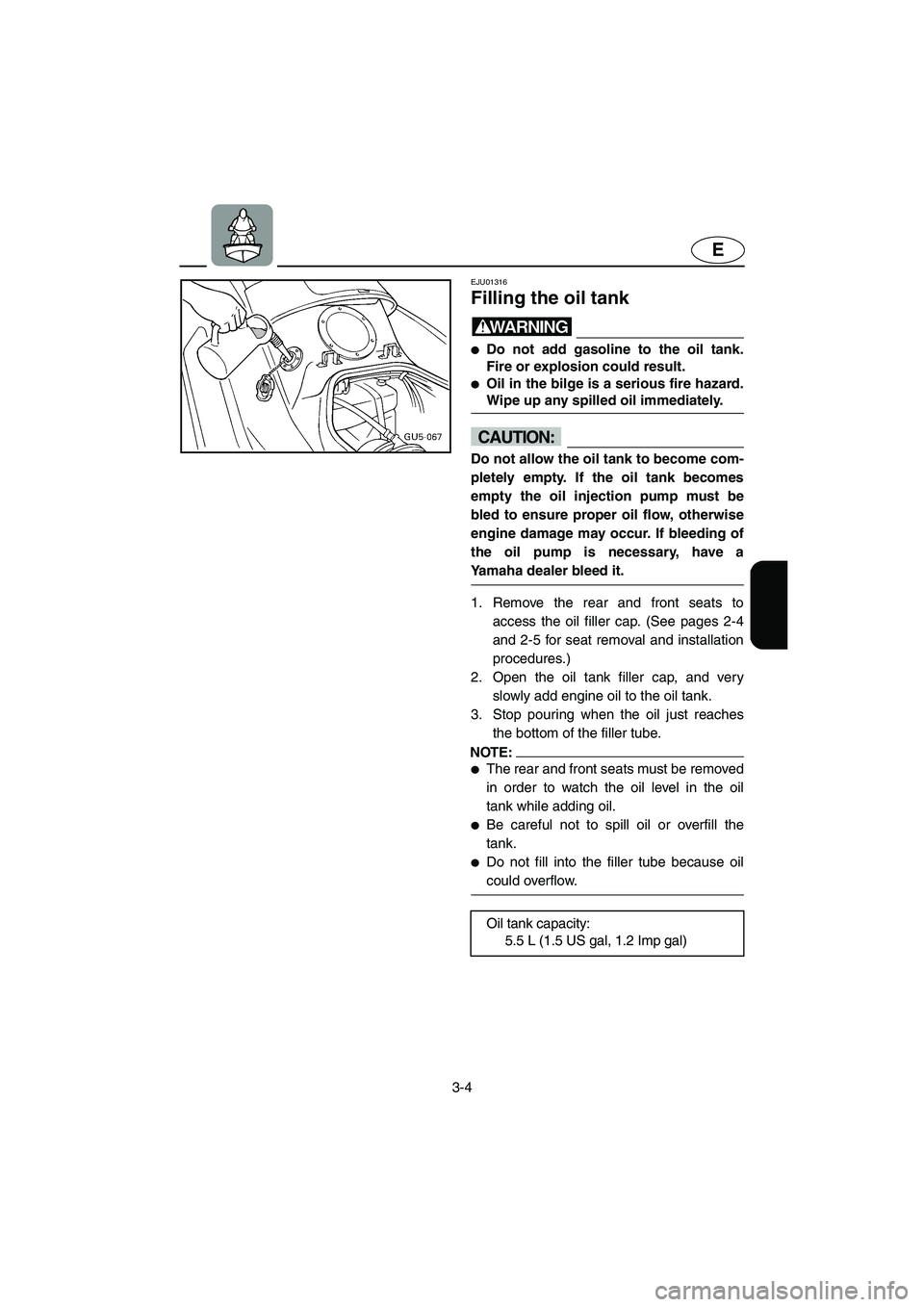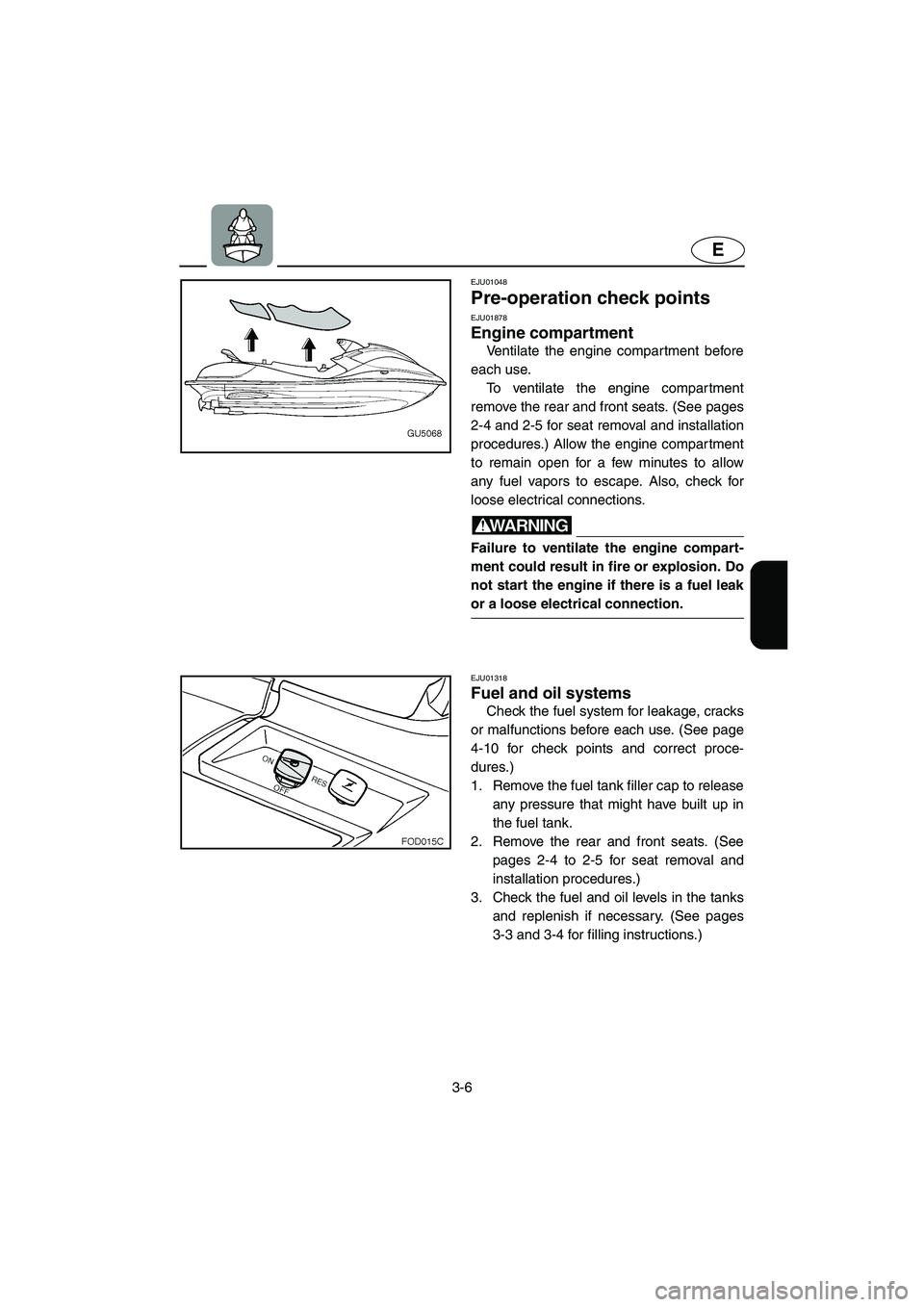Page 30 of 134
2-5
E
EJU01859
Front seat
To remove the front seat:
1. Remove the rear seat.
2. Pull the front seat latch 1 up, and then
pull the seat off.
To install the front seat:
1. Insert the projections on the front of the
seat into the stays on the deck, and then
push the rear of the seat down to lock it
in place.
2. Install the rear seat.
NOTE:@ Make sure that the seats are properly
secured before operating the watercraft.
@
UGU572.book Page 5 Wednesday, August 28, 2002 1:31 PM
Page 32 of 134
2-7
E
EJU01012
Fuel tank filler cap
To remove the fuel tank filler cap 1, turn it
counterclockwise.
NOTE:@ Make sure that the fuel tank filler cap is
properly secured before operating the water-
craft.
@
EJU01954
Oil tank filler cap
To remove the oil tank filler cap:
1. Remove the rear and front seats. (See
pages 2-4 to 2-5 for rear and front seat
installation and removal procedures.)
2. Turn the filler cap 1 counterclockwise.
To install the oil tank filler cap:
Install the filler cap, and then install the
seats.
NOTE:@ Make sure that the oil tank filler cap is prop-
erly secured before operating the watercraft.
@
UGU572.book Page 7 Wednesday, August 28, 2002 1:31 PM
Page 60 of 134

3-3
E
EJU01960
Filling the fuel tank
CAUTION:@ Be careful when refueling. Avoid getting
water or other contaminants in the fuel
tank. Contaminated fuel can cause poor
running or engine damage.
@
1. Remove the rear and front seats. (See
pages 2-4 to 2-5 for seat removal and
installation procedures.)
2. Remove the fuel tank filler cap, and
slowly add fuel to the fuel tank.
3. Stop filling when the fuel level just
reaches the bottom a of the engine oil
tank.
4. Add 15 L (4 US gal, 3.3 Imp gal) to fill the
fuel tank.
WARNING@ Do not add more than 15 L (4 US gal,
3.3 Imp gal) to the fuel tank, otherwise
fuel can overflow when filling the fuel
tank or when it warms up and expands.
@
NOTE:@ �The fuel tank is full when the fuel level b
is visible behind the oil tank.
�The rear and front seats must be removed
in order to watch the fuel level in the fuel
tank while adding fuel.
�Do not fill into the filler tube because gas-
oline could overflow.
@
Fuel tank capacity:
Total: 70 L (18.5 US gal, 15.4 Imp gal)
Reserve: 12 L (3.2 US gal, 2.6 Imp gal)
UGU572.book Page 3 Wednesday, August 28, 2002 1:31 PM
Page 61 of 134

3-4
E
EJU01316
Filling the oil tank
WARNING@ �Do not add gasoline to the oil tank.
Fire or explosion could result.
�Oil in the bilge is a serious fire hazard.
Wipe up any spilled oil immediately.
@
CAUTION:@ Do not allow the oil tank to become com-
pletely empty. If the oil tank becomes
empty the oil injection pump must be
bled to ensure proper oil flow, otherwise
engine damage may occur. If bleeding of
the oil pump is necessary, have a
Yamaha dealer bleed it.
@
1. Remove the rear and front seats to
access the oil filler cap. (See pages 2-4
and 2-5 for seat removal and installation
procedures.)
2. Open the oil tank filler cap, and very
slowly add engine oil to the oil tank.
3. Stop pouring when the oil just reaches
the bottom of the filler tube.
NOTE:@ �The rear and front seats must be removed
in order to watch the oil level in the oil
tank while adding oil.
�Be careful not to spill oil or overfill the
tank.
�Do not fill into the filler tube because oil
could overflow.
@
Oil tank capacity:
5.5 L (1.5 US gal, 1.2 Imp gal)
UGU572.book Page 4 Wednesday, August 28, 2002 1:31 PM
Page 62 of 134

3-5
E
EJU01346
Pre-operation checks
EJU01347
Pre-operation check list
Before operating this watercraft, perform the checks in the following check list. See the
accompanying text in this chapter for details on how to perform the checks.
WARNING@ If any item in the pre-operation check list is not working properly, have it inspected
and repaired before operating the watercraft, otherwise an accident could occur.
@
NOTE:@ Pre-operation checks should be made thoroughly each time the watercraft is used. This pro-
cedure can be completed in a short time. It is worth the time spent to assure safety and reli-
ability.
@
ITEM ROUTINE PAGE
Engine compartment Remove all seats to ventilate the engine com-
partment. Check for fuel vapors or loose electri-
cal connections3-6
Bilge Check for water and fuel residue and remove if
necessary3-7
Throttle Check that the throttle lever springs back 3-10
Steering system Check for proper steering system operation 3-10
Shift lever and reverse gate Check for proper operation 3-11
Fuel and oil Check fuel and oil level and add if necessary
Check hoses and tanks for leakage3-6
Water separator Check for water and drain if necessary 3-7
Battery Check electrolyte level and battery condition 3-8
Front and rear seats Check that the seats are properly secured 2-4–2-5
Hull/Deck Check the hull and deck for cracks or other dam-
age—
Jet unit Check for debris and remove if necessary 3-12
Fire extinguisher Check the condition and replace if necessary 3-9
Engine shut-off cord Check condition and replace is frayed or broken 3-12
Switches Check the start switch, engine stop switch and
engine shut-off switch for proper operation when
the watercraft is in the water3-13
Cooling water pilot outlet Check that water is discharged while the engine
is running and the watercraft is in the water3-13
Multifunction meter Check for warning indications and proper opera-
tion3-13
UGU572.book Page 5 Wednesday, August 28, 2002 1:31 PM
Page 63 of 134

3-6
E
EJU01048
Pre-operation check points
EJU01878
Engine compartment
Ventilate the engine compar tment before
each use.
To ventilate the engine compartment
remove the rear and front seats. (See pages
2-4 and 2-5 for seat removal and installation
procedures.) Allow the engine compartment
to remain open for a few minutes to allow
any fuel vapors to escape. Also, check for
loose electrical connections.
WARNING@ Failure to ventilate the engine compart-
ment could result in fire or explosion. Do
not start the engine if there is a fuel leak
or a loose electrical connection.
@
EJU01318
Fuel and oil systems
Check the fuel system for leakage, cracks
or malfunctions before each use. (See page
4-10 for check points and correct proce-
dures.)
1. Remove the fuel tank filler cap to release
any pressure that might have built up in
the fuel tank.
2. Remove the rear and front seats. (See
pages 2-4 to 2-5 for seat removal and
installation procedures.)
3. Check the fuel and oil levels in the tanks
and replenish if necessary. (See pages
3-3 and 3-4 for filling instructions.)
UGU572.book Page 6 Wednesday, August 28, 2002 1:31 PM